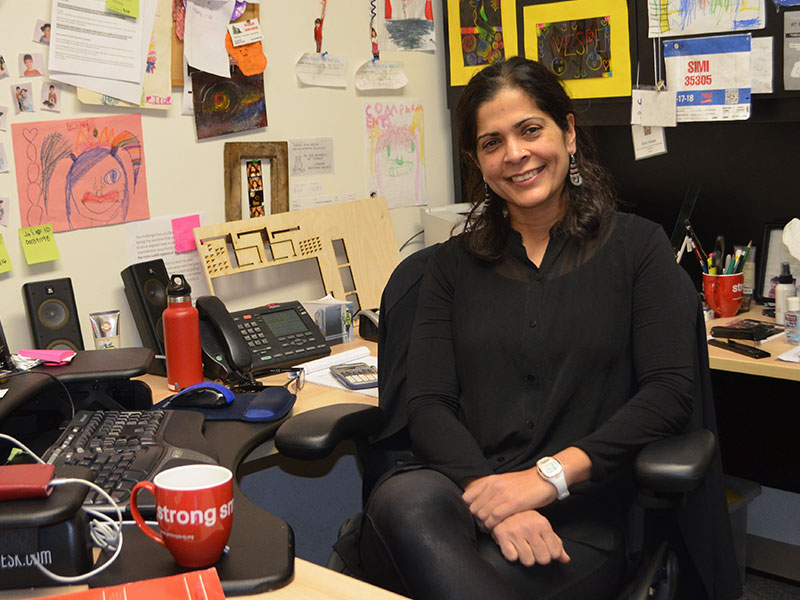According to a NOAA report released last September, 2020 was the warmest summer ever in the Northern Hemisphere, surpassing 2019 and 2016. And because many people were working from home due to the pandemic, it was also likely one of the biggest years for energy use by air conditioners. More energy use means a larger carbon footprint, which means accelerated climate change. How can we mitigate this vicious cycle, protecting our own comfort and health while also safeguarding the environment?

Simi Hoque
The question is one that’s often on the mind of Simi Hoque, PhD, PE, associate professor of civil, architectural and environmental engineering. Hoque’s work focuses on developing computational tools to model, evaluate, and predict the impact of climate change on energy and water use, land use, and transportation systems at an urban scale.
Hoque began her career as a designer in an architecture firm, and because of her training in engineering, often found herself coordinating between her firm and the engineers they worked with. When the recession forced layoffs at the architecture firm, one of the engineering groups was quick to bring her on board.
“I wound up working on energy systems design for low-incoming housing in Massachusetts,” she says. “It was really fulfilling to go into these housing projects and design systems for people to be comfortable and healthy inside their homes.”
Because houses in these areas need to be affordable, Hoque explains, public housing projects are often built with less durable and inefficient materials, leaving them prone to air and water damage from the outside. This can make it more difficult to maintain a comfortable indoor temperature and can make them susceptible to mold, pests and other harmful contaminants.
“We also saw a lot of homes where the heating and cooling systems failed because they were oversized or undersized for the space, with little to no ventilation,” Hoque says. “There were so many simple fixes we could make to drastically improve the health and safety of the residents.”
Fixing suboptimal buildings — when advocating to have them built correctly in the first place isn’t possible — can benefit more than just the homeowners. It can reduce the energy burden of the municipality. So Hoque applied for an NSF CAREER grant to study how making changes across a city can better protect its residents. It’s this that brought her to Philadelphia and Drexel.
“Working in western Massachusetts, I didn’t have a lot of access to city-scale planning,” Hoque says. “Moving to Philadelphia allowed me to look at an actual city rather than doing something hypothetical. And Drexel already had some of the best minds in the Architectural Engineering programs studying these issues, so it was a natural fit.”
Looking at the issue with a wider lens, Hoque realizes that even buildings that are well designed now may not be able to keep up with the pace of climate change, so she is developing tools to analyze urban energy use and make recommendations. Some of these rare as simple as installing window shades, which many office buildings don’t have, to mitigate overheating and glare or for companies to consider changing working hours so people come into the office when it’s cooler.
“There is a clear link in my mind that if you improve the standard of the buildings in which people live, you will improve their health and well-being.”
Simi Hoque
While Hoque’s work on energy efficiency can save money and help with city planning, her greatest concern is for the health and well-being of building occupants.
“Here in Philadelphia there's an enormous sort of population of people who are suffering because of the conditions of the houses they live in,” she says. “In addition to the health dangers of poor climate control and mold and pest infestations, there’s the stress of paying utility bills that are artificially high. There is a clear link in my mind that if you improve the standard of the buildings in which people live, you will improve their health and well-being.”
To that end, Hoque is expanding on this philosophy through a partnership with the Children’s Hospital of Philadelphia to study how acoustics, lighting and the thermal environment in a hospital can help with healing.
“We're looking at stress levels among patients in different hospital rooms and seeing whether these are correlated with the environment,” she explains. “This also plays a part in the work that I'm doing with researchers in the School of Public Health, to study whether the asthma burden of those who live in substandard housing can be addressed with energy-saving interventions, such as weatherization and better indoor air quality. We recently were awarded a Longsview Fellows grant to seed this research.”